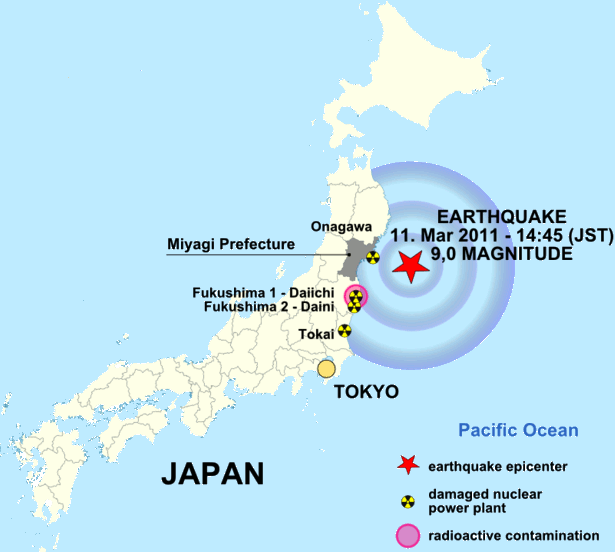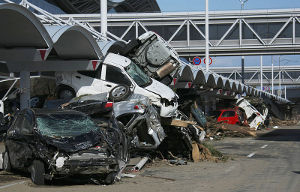Cascading disasters in the country of the rising sun
An earthquake with a rare intensity
 © Maximilian Dörrbecker, CC BY-SA 3.0 (modified picture) © Maximilian Dörrbecker, CC BY-SA 3.0 (modified picture) |
Of magnitude 9, this earthquake, which occurred 300 km off the coast of Sendai, is one of the most powerful ever recorded. It caused a 500 km-long submarine fracture zone. It has also shifted the seabed more than 10 meters, creating a mass of moving water and a destructive tsunami whose waves reached 10 meters in height.
According to the United States Geological Survey, USGS, this powerful shock appears to have moved Honshu, the main island of the Japanese archipelago by 2.4 meters and may have diverted the earth’s rotational axis by nearly 10cm.
Located on the Pacific Ring of Fire, at the junction of four tectonic plates, Japan has been undergoing the most violent earthquakes.
Unprecedented material damages
Beyond the human toll that gets heavier every day (by March 30, 2011, a provisional toll has reported 12 232 dead and 16 361 missing), the material damages caused by the earthquake and tsunami will have serious consequences on the economy of Japan.
This outburst of nature has caused:
- the devastation of several cities in the Northeast,
- the total or partial collapse of 88 000 houses,
- the destruction of infrastructure,
- damages in several economic sectors.
 To this direct damages are added power outage following the stoppage of 10 nuclear reactors, the deterioration of roads and closure of ports and airports. Whole sections of the Japanese industry as metallurgy, information technology, automotive electronics, have, thus, become paralyzed.
To this direct damages are added power outage following the stoppage of 10 nuclear reactors, the deterioration of roads and closure of ports and airports. Whole sections of the Japanese industry as metallurgy, information technology, automotive electronics, have, thus, become paralyzed.
The risk of a nuclear catastrophe
In addition to the earthquake and tsunami, Japan is facing serious problems in one of its nuclear plants. Located in the disaster area, the site of Fukushima, which has 10 reactors, was left without cooling system. Rising temperatures in the core of the six reactors have already caused several explosions, fires and spill of highly radioactive discharges into the atmosphere. Since then, the radioactivity level has continued to rise dangerously in the region.
According to the French nuclear safety authority, the nuclear accident has reached the severity level of 6 on an international scale of 7. The Chernobyl disaster is at level 7.
A nasty bill for insurance
The financial cost of this double natural disaster goes up each day a little more and could eventually reach 310 billion USD, that is nearly 8% of the GDP. If this figure is confirmed, this event is about to become the costliest natural catastrophe in history, well ahead that of hurricane Katrina (125 billion USD) which lashed New Orleans in 2005.
According to the modeling company AIR Worldwide, the insured losses would amount to 21 billion USD just for the earthquake alone. The total bill, including the tsunami-caused damages, is likely to exceed 31 billion USD.
In Japan, the seismic risk insurance is facultative. According to Fitch, this hazard is underwritten by only 14 to 17% of the owners. It is Japan Earthquake Reinsurance (JEK), a national entity supplied by all Japanese non-life insurers and by the State, which will handle most of the losses sustained by individuals. Its indemnification capacity amounts to 5500 billion JPY (67.6 billion USD) according to Moody's.
International reinsurers will also sustain a significant share of the losses. They will be involved through the insurance policies pertaining to industrial and commercial risks. They will also participate as reinsurers of "Kyosai" (Japanese mutuals) for personal lines risks.
The exposure of the main reinsurers is poised to reach 2.1 billion USD for Munich Re (which holds 12% of the Japanese reinsurance market), 1.2 billion USD, for Swiss Re, 259 million USD for Scor and 350 million USD for Hannover Re. Berkshire Hathaway, Partner Re and Everest Re shall also be involved.
Regarding the coverage of nuclear plants, insurers generally exclude damages caused by earthquakes or tsunamis. The risk of nuclear contamination is also ruled out of real estate coverage. The bill for damages caused by nuclear power plants will be handed to Tepco, the manager of the Fukushima plant and to the Japanese government.
The costliest earthquakes
in billions USD
| Magnitude | Year | Country | Number of deaths | Total cost | Insured cost | |
|---|---|---|---|---|---|---|
Sendai (with tsunami)1 | 9 | 2011 | Japan | 12 232 | 310 | 31 |
Kobe | 7.2 | 1995 | Japan | 6 437 | 100 | 7.4 |
Sichuan | 7.9 | 2008 | China | 87 000 | 85 | 0.3 |
Northridge | 6.7 | 1994 | United States | 61 | 44 | 15.3 |
Chile (with tsunami) | 8.8 | 2010 | Chile | 521 | 30 | 8 |
Honshu, Niigata | 6.8 | 2004 | Japan | 67 | 28 | 0.76 |
Christchurch2 | 6.3 | 2011 | New Zeland | 200 | 20 | 10 |
Sumatra (with tsunami) | 9.1 | 2004 | Indonesia | 300 000 | 10 | 4 |
1 For the earthquake of Sendai, the number of deaths, the total cost and the insured cost are provisional 2 For the earthquake of Christchurch, the total cost and the insured cost are provisional
